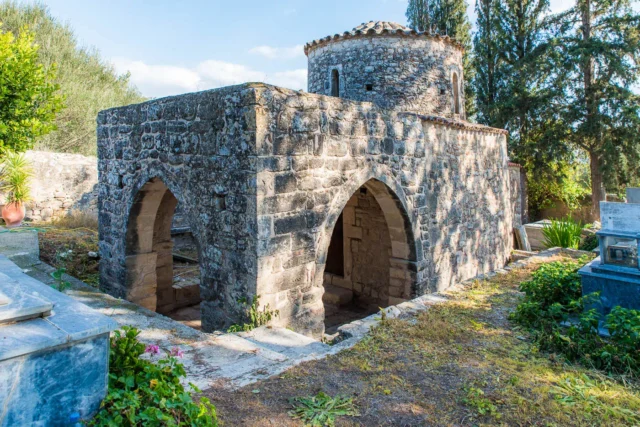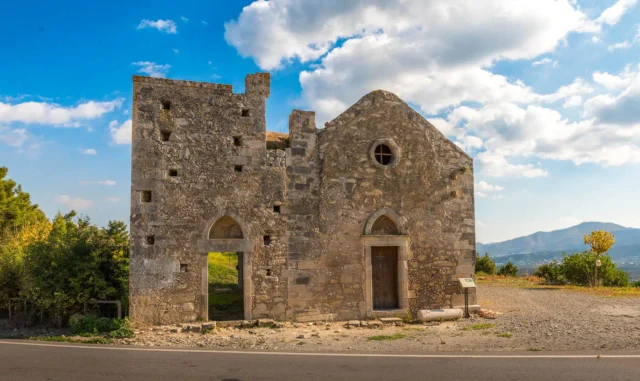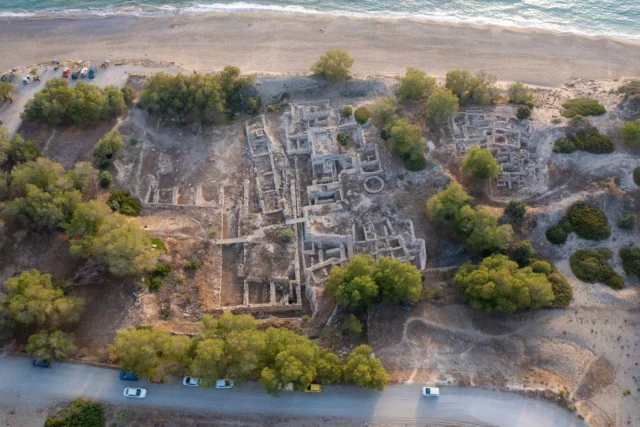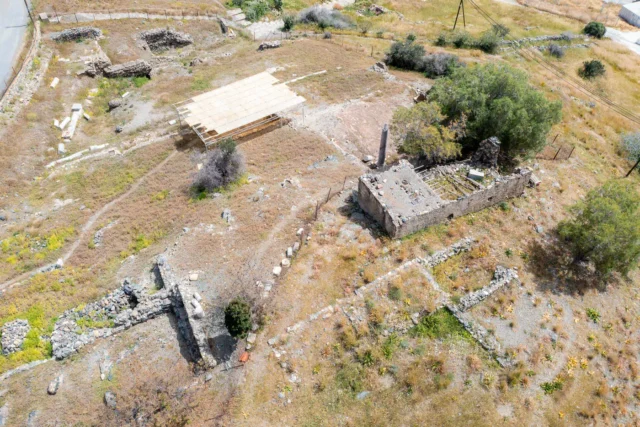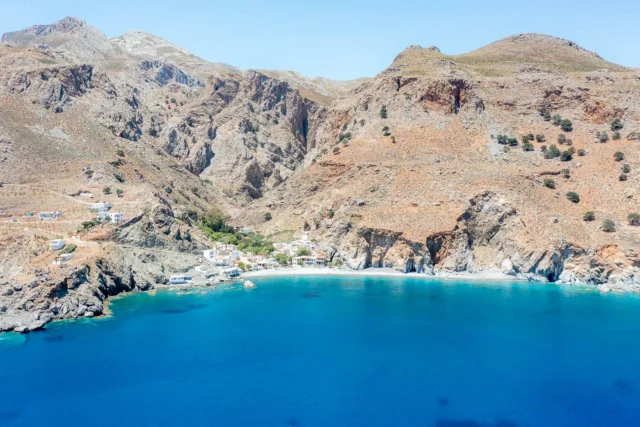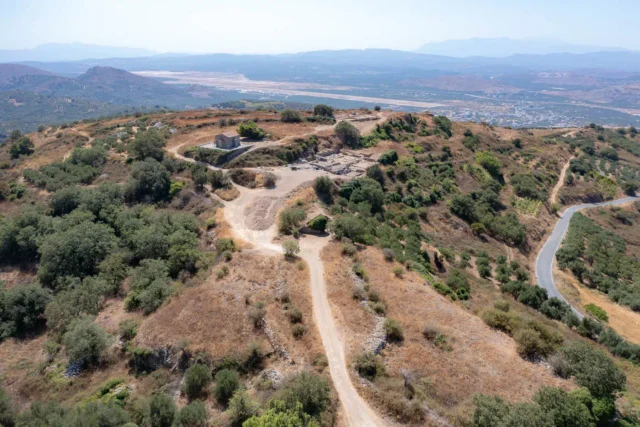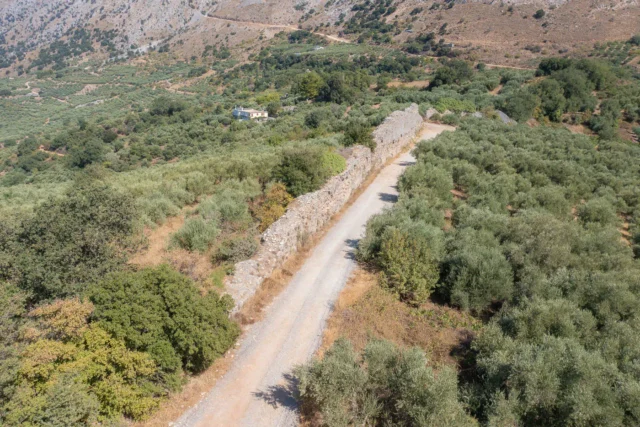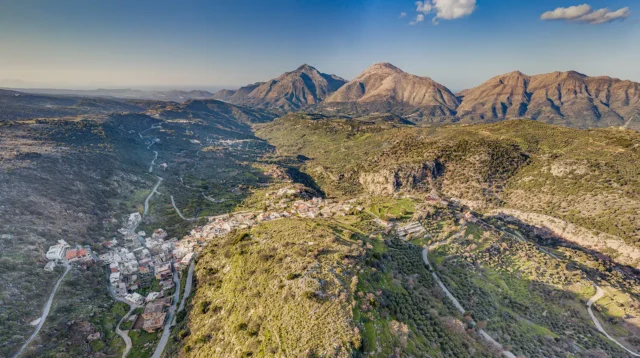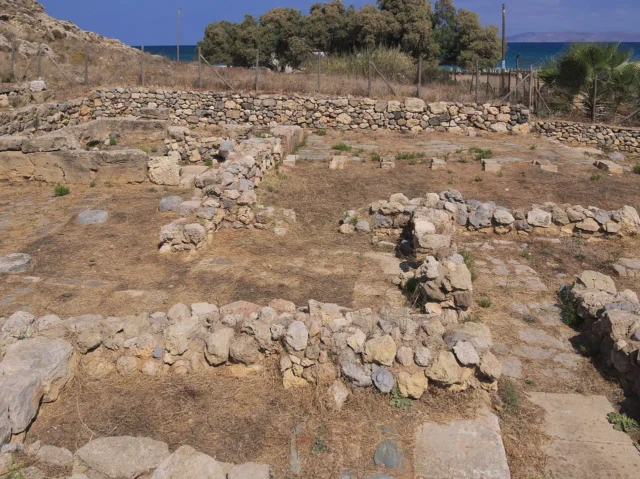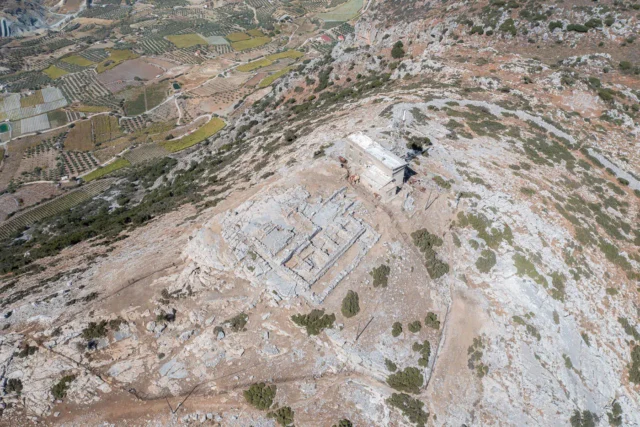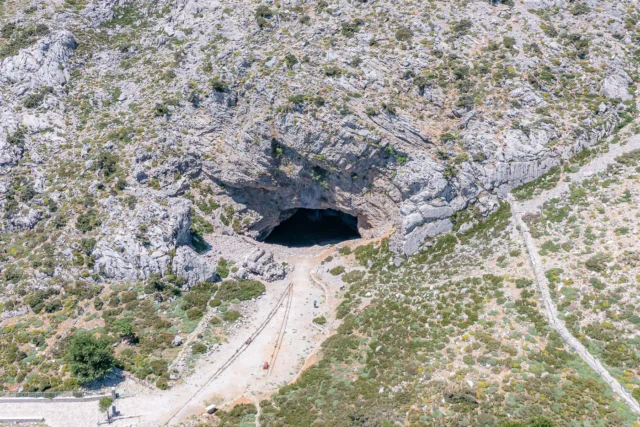748
listings found
Categories
Active filters:
Aghios Pavlos (Saint Paul)
The Church of Saint Paul, a 13th-century Byzantine church near Kamilari, Crete, features a large narthex and frescoes.
Aghios Georgios Falandras
Venetian-era monastery destroyed in 1821. Its history intertwines with Crete's religious traditions and fight for Greek independence.
Kommos archaeological site
Located on Crete's south coast, this site was a major Minoan harbor town for Phaistos and later a Greek sanctuary. It features monumental Minoan structures like Building T, shipsheds (Building P), and the significant residence House X. During the Greek and Roman periods, successive temples (A, B, C) were built over Minoan ruins. Finds of imported pottery from Egypt and Cyprus confirm its role as a trade hub. Abandoned in the Roman era, it is now a protected archaeological site.
Lebena (Leveen)
Lebena, an ancient city on Crete's southern coast, is renowned for its Sanctuary of Asclepius, the Greek god of medicine. The city's strategic location near a good harbor and its association with the healing cult of Asclepius made it an important center for both trade and religious pilgrimage. Lebena was also a significant port for trade and commerce with the East during the Prepalatial period. The site of Lebena has a long history of occupation, with evidence of inhabitation dating back to the Neolithic and Early Minoan periods (ca. 3rd millennium BC). The presence of a variety of Eastern imports in secure Prepalatial contexts at Lebena, including faience, gold, ivory, and Egyptian scarabs, suggests that Lebena was a significant port for trade and commerce with the East during this time. In the Late Classical period (ca. 4th century BC), the Gortynians established the sanctuary dedicated to Asclepius at the harbor. The city was destroyed by a powerful earthquake in 46 BC but was subsequently rebuilt. The sanctuary continued to flourish throughout the Roman period, as evidenced by the numerous inscriptions and archaeological finds from the site. The strategic location of Lebena on the south coast of Crete made it an ideal location for a port. The sheltered bay would have provided a safe harbor for ships, and the proximity to the Asterousia Mountains would have offered protection from storms. Additionally, Lebena's location on the south coast would have made it a convenient stopping point for ships traveling between the Aegean and the Near East. The presence of Eastern imports at Lebena suggests that the site was an important point of contact between Crete and the East during the Prepalatial period.
Ancient Lyktos (or Lyttos)
Lyttos, once known as Lyktos, is an ancient city steeped in history, with possible roots in the Minoan civilization. Archaeological evidence suggests a vibrant past, with the city flourishing through the Mycenaean, Archaic, Classical, Hellenistic, and Roman periods. The city's strategic location and powerful alliances contributed to its prominence in Crete. Excavations have revealed significant structures, including fortifications, public buildings, and residential areas, offering a glimpse into Lyttos' rich cultural heritage.
Aqueduct of Lyttos
Explore the remarkable Aqueduct of Lyttos, a testament to Roman engineering ingenuity in ancient Crete. Discover how this impressive structure supplied water to the elevated city of Lyttos, ensuring its prosperity.
Ancient Axos (Oaxos)
Oaxos, also known as Axos, was an ancient Cretan city in the Mylopotamos region, inhabited from the Neolithic to the Venetian period. It was known for its strategic location, association with the Idaean Cave, and connections with cities like Knossos and Eleutherna.
Archaeological findings reveal remnants from various periods, including cyclopean walls, terracotta idols, and bronze molds. Oaxos participated in interstate contracts and had its own coinage, featuring Apollo, Artemis, and Zeus, reflecting religious beliefs. The city was a member of the Cretan "Koinon."
Oaxos was eventually destroyed by the Venetians. Today, only a few ruins remain, with some artifacts housed in the Heraklion Archaeological Museum.
Amnisos Sanctuary of Zeus Thenatas
The Sanctuary of Zeus Thenatas at Amnisos, located on the north-central coast of Crete near Heraklion, is an archaeological site with a rich history spanning from the Bronze Age to the Early Iron Age. The sanctuary is dedicated to Zeus Thenatas, a deity associated with both Minoan and Mycenaean traditions. Amnisos, mentioned in Homer's Odyssey, was a significant center for maritime activities and trade during the Bronze Age. Excavations have revealed a 44-meter-long ashlar wall, smaller podia, and a thick layer of ash and burnt animal bones, suggesting animal sacrifice and ritual feasting. Votive offerings include bronze tripods, figurines, miniature weapons, and terracotta figurines of bulls and horses. The sanctuary exemplifies the continuity and change in Cretan religious practices, with the site's dedication to Zeus Thenatas reflecting Minoan traditions, while the adoption of new votive practices and the presence of faience objects highlight the evolving nature of religious expression. The sanctuary was operational from the Protogeometric period (c. 900 BC) to the end of the Early Iron Age (c. 600 BC), with two main phases of use marked by the construction of two temples: Temple A (Late Subminoan period to around 800 BC) and Temple B (around 800 BC to c. 600 BC).
Amnisos Villa of the Lilies
Amnissos, an ancient Minoan port city located on Crete's north coast, boasts the luxurious Villa of the Lilies. This two-story villa, constructed with ashlar blocks during the Middle Minoan IIIA period (around the 17th century BC), features a hall with multiple doors, a bathroom, stairs, and covered paved areas. Its name comes from the frescoes of lilies that once decorated its walls. The villa, excavated in 1932 by Spyridon Marinatos, was likely destroyed by an earthquake or tidal wave around 1500 BC. Amnissos is also significant for its mythological connection to Zeus, whose omphalos (navel) is said to have fallen there. The area was referred to as the Omphalian Plain. The name Amnissos appears in Linear B inscriptions, indicating its importance to the Minoan civilization. The presence of the harbor, various buildings, and an open-air archaic sanctuary dedicated to Zeus further underscores its historical significance.
Giouchtas Minoan Peak Sanctuary
The Giouchtas Minoan Peak Sanctuary, located on the mountain of Giouchtas near Epano Archanes in Crete, is an archaeological site dating back to the Early Bronze Age. The site is associated with Minoan religion and offers insights into the ritual practices and beliefs of the Minoan civilization. Archaeological investigations have revealed structures, including a temenos, and artifacts like clay figurines and pottery fragments. The sanctuary's location on a mountain peak is characteristic of Minoan peak sanctuaries, chosen for its association with the divine realm and visibility. The Giouchtas sanctuary is located near Knossos and Archanes, suggesting it played an important role in the religious and social life of the Minoan people.
Acropolis Smari
The Acropolis of Smari, located on the peak of Prophet Elias near Smari, Crete, is an archaeological site with ruins dating back to the Minoan period (1800 BC to 630 BC). The site features a sanctuary dedicated to Athena Ergani, with ceramic plaques depicting the goddess considered the oldest representations of Athena in Crete. The Acropolis is enclosed by a strong defensive wall and contains settlements, buildings, and terraces for cultivation. Excavations have revealed structures like Megaron A, Megaron B, and Megaron Δ, each with unique features. The walls surrounding the hilltop are the most significant structures, built with large limestone blocks and smaller rectangular stones.
Monumental Olive Tree of Paliama
Ancient olive tree near Moroni, Crete, designated "Monumental" with unique trunk and historical significance.
Karphi archaeological site
Karphi, a Late Minoan IIIC refuge village in Crete, perched high above the Lasithi Plateau, offers a glimpse into Minoan resilience during a time of upheaval. Excavated in the late 1930s, the site reveals a planned settlement with houses, streets, and evidence of diverse cult activities. Its strategic location provided a defensive advantage, offering panoramic views of the Lasithi plain and north-central Crete. The village likely served as a refuge for Minoans seeking safety and survival after the collapse of the Minoan palaces. Despite the harsh conditions, the village featured paved streets, yards, and single-story houses, suggesting a planned and organized community. Karphi stands out for its diverse and widespread cult activities, with shrines dedicated to goddesses and various ritual artifacts. The Temple served as the central focus for ritual activities, housing goddess figures, snake tubes, braziers, and fireboxes. Other areas, such as the Commercial Quarter and the Great House Shrine, also contained evidence of cult practices. Rooms containing offering stands, figurines, and libation vessels indicate that rituals were not confined to formal shrines, suggesting a more informal setting for community offerings. This decentralized approach to ritual practices distinguishes Karphi from other LM IIIC sites.
Ancient Olive Tree in Goulediana
The Goulediana olive tree, a mastoeidis variety, dates to approximately 1750 years old, evidenced by its growth rings. This 12-meter tall tree with a 17.5-meter circumference reflects the deep-rooted tradition of olive cultivation in Crete, near the Onithe archaeological site. The tree symbolizes peace, prosperity, and longevity, central to Cretan culture and economy. Olive oil is a staple in the Cretan diet, and the olive harvest is a significant annual event, highlighting the tree's cultural significance and historical importance. The gnarled trunk shows centuries of growth, connecting to the area's ancient economic activities.
Sklavokambos
The Sklavokampos Farm Estate, a significant Late Minoan period archaeological site in Crete, Greece, offers a unique window into Minoan life. Discovered in 1930, the estate is located southwest of Heraklion, near Tylissos. The estate's strategic location near the Minoan road network and the fertile Messara Plain suggests it played a crucial role in agricultural production and trade. The estate's architecture is simpler than Minoan palaces, featuring 17 rooms across three levels. The site includes a main room with artifacts like a clay ox head, a Late Minoan IB jug, and a stone rhyton. Sealings from Sklavokampos have been found at other Minoan sites such as Zakros, Gournia, and Hagia Triada, indicating connections across Crete. The estate also housed a small shrine, storerooms for agricultural products, and a toilet with an underground drain. Evidence suggests the estate was part of a larger settlement destroyed by fire, possibly during the Late Minoan IB period.
Ideon Antro cave
Ideon Antron Cave, also known as "Spiliara" or "Cave of the Shepherdess," is located high on the slopes of Mount Ida on the Nida Plateau, Crete, 20 km from Anogia village at 1498 meters above sea level. In Greek mythology, this is where Rhea hid Zeus from Cronus. Archaeological excavations have revealed a rich history of human activity, dating back to the Neolithic period. The cave was used for worship for centuries, with peak activity during the Geometric and Archaic periods. It's open to the public from July to November, except on Tuesdays.
Trypiti Minoan settlement
Trypiti: An Early Minoan Settlement Perched on a Cretan Hilltop The Early Minoan settlement of Trypiti, located on a rocky hill overlooking the bay of Trypiti in southern Crete, offers […]
Roman tombs on Gra Mantra
Agios Thomas, a Cretan mountain village, features distinctive rock-cut architecture, including Minoan wine presses and Roman tombs. The area, marked by impressive rock formations and natural caves, hosts Byzantine churches and lush greenery. Gra Mantra, a burial monument, contains numerous Roman tombs. A chapel of Kera Spiliotissa near Ardachtia displays a Greco-Roman inscription indicating a sanctuary dedicated to Larki Artemis, Demeter, and Kore. Evidence suggests a cult dedicated to chthonic deities, with local customs reflecting this. The village, part of the Gortyna Municipality, is rich in water and orchards, with a unique geological landscape.









